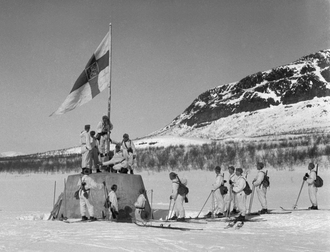
Finland participated in the Second World War initially in a defensive war against the Soviet Union, followed by another, this time offensive, war against the Soviet Union acting in concert with Nazi Germany and then finally fighting alongside the Allies against Germany.
The first two major conflicts in which Finland was directly involved were the defensive Winter War against an invasion by the Soviet Union in 1939, followed by the offensive Continuation War, together with Germany and the other Axis Powers against the Soviets, in 1941–1944. The third conflict, the Lapland War against Germany in 1944–1945, followed the signing of the Moscow Armistice with the Allied Powers, which stipulated expulsion of Nazi German forces from Finnish territory.
The Soviet attempt to conquer Finland in the Winter War was thwarted,[1][2] and by the end of World War II, Finland remained an independent country. However, Finland ceded approximately 10% of its territory to the Soviet Union, including Viipuri (Finland's second-largest city [Population Register] or fourth-largest city [Church and Civil Register], depending on the census data[3]). Finland was also required to pay out a large amount of war reparations to the Soviet Union and to formally acknowledge partial responsibility for the Continuation War. Finnish political policy during the Cold War was aimed at appeasing the Soviet Union in order to maintain good relations.
- ^ Zeiler and DuBois (2012) p. 210
- ^ Reiter (2009), p. 124
- ^ Statistics Finland (1940)